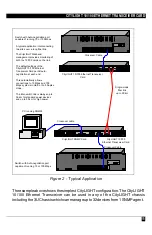
CITYLIGHT 10/100 ETHERNET TRANSCEIVER CARD
12
Auto-negotiation is enabled by setting switch 2 to ON; see Section 5, Switch
Positions. Setting switch 2 OFF allows the data rate to be controlled by the
speed select switch (Switch 1); see Section 5, Switch Positions.
2.2 Data Rate
The CityLIGHT Fiber Extender Modules can operate at either 10 or 100 Mbps.
Switch 1 controls the speed whenever auto-negotiation is not enabled; see
Section 5, Switch Positions:
ON – 100 Mbps.
OFF – 10 Mbps.
The CityLIGHT 10/100 Ethernet Transceiver works transparently with either full-
or half-duplex ports attached, though users should be aware distance is limited by
the Ethernet protocol in half-duplex environments.
2.3 Frame Size
The CityLIGHT 10/100 Ethernet Transceiver transparently supports all frame
sizes including longer frames used for VLAN tagging. This includes transmission
of 802.1q VLAN tagged frames as well as ISL 1548 byte length frames.
2.4 Drive Distance
The CityLIGHT 10/100 Ethernet Transceiver allows a user to connect LAN
interfaces over extended distances. Each copper port has a maximum drive
distance of 100 m on UTP cables. Every CityLIGHT 10/100 Ethernet Transceiver
fiber link can be up to 35 km using standard optics or 50 km using high-power
optics. Two launch-power options are available; a standard-power unit typically
launching at -10 dBm and a high-power unit at -3 dBm. All units receive to a
minimum light level of -28 dBm. See Specifications for more details.
2.5 External Attenuator
All high-power or long haul CityLIGHT cards have been designed for long distance
transmission and provide a minimum optical budget ranging between 20dB and
25dB. This provides transmission distances between 40km and 50km based on
an average fiber attenuation of 0.5dB/km.
When these products are used for short distance applications, the received
power may exceed the saturation limit of the receiver and external
attenuation will be necessary to prevent optical overload and the inevitable
data errors.












































